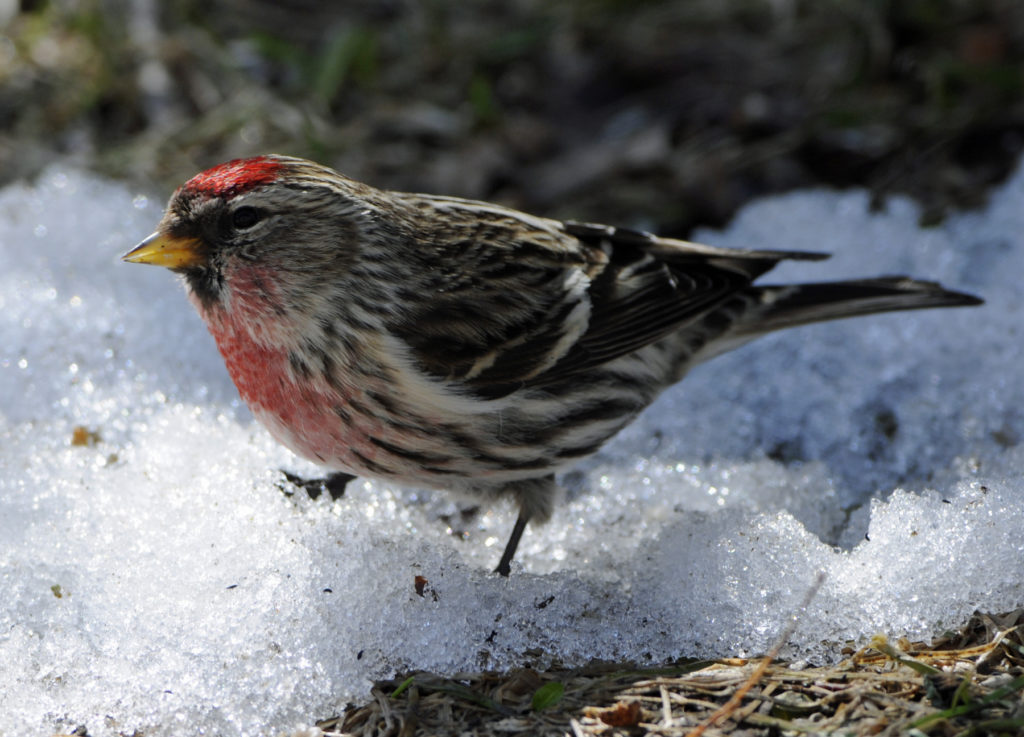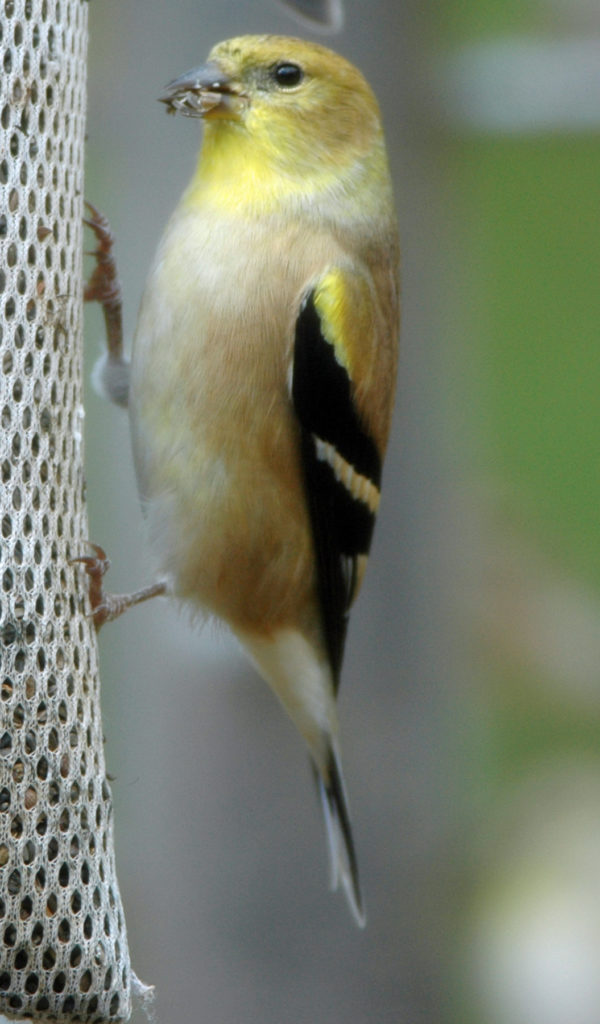Door to Nature: Winter Finches
- Share
- Tweet
- Pin
- Share

Spring is an exciting time to go bird-watching. We await the arrival of many species returning from the south in April and May, showing their colorful breeding plumage. Autumn is a rewarding bird-watching season as well, but it’s a more challenging time to identify migrating birds because adults have subdued, post-breeding “attire,” and the immature birds’ first-year feathers are not as brilliant as those of breeding adults. There’s also not much territorial singing going on during the fall.
Once winter arrives, there are fewer species visiting the feeders. The year-round residents such as blue jays, mourning doves, chickadees, nuthatches and woodpeckers aren’t as exciting to observe, so this is when we look for more exotic species to come down from the far north to spend the colder months in our county.
Summer is the season when birds sing, stake out their territories and breed. During the winter, in contrast, it’s a challenge for most species just to find enough food and seek shelter from predators. Winter weather has a lot to do with these factors, as does the health of trees in North America.
Each autumn, we look forward to the winter finch forecast from a scientist in Canada. He predicts which species might be expected to appear in large numbers in the northern United States by studying the seed production on the conifers and deciduous trees in the north.
Bird food during the cold months is mostly found on trees such as birches and maples, in the form of fruits on other trees and shrubs, and as seeds in conifer cones. If the growing conditions in the far north have been poor, then fewer seeds will have been produced, and birds must fly farther south to stay alive.
One bird many people look for is the snowy owl. The food source for that species is a small mammal called the lemming, whose populations can rise and fall year by year. When snowy owls appear in our state, they are often youngsters, and many are starving.

This article concerns the smaller songbirds that often show up at our feeders or along roadsides where crabapple trees have abundant fruit. A few grosbeaks will be included with the finches.
One of the most fascinating species that may show up unexpectedly is the crossbill. Red crossbills tend to move around the country and nest wherever and whenever they see the opportunity. There are numerous forms of this species, which are distinguished by their songs and calls.
The white-winged crossbill tends to be more of a winter visitor here and may stay in one area for several months. The beak of this species is specially formed to aid the birds in extracting seeds from under conifer-cone scales. The white-winged crossbill has also nested in each month of the year when conifer seeds are abundant.
The adult males of both species have rosy red feathers, and females are a dull yellowish-brown. The main difference is the two distinct, white wing bars seen in the white-winged species. They may travel in large flocks and often emit their calls while in flight. One crossbill can consume up to 3,000 conifer seeds per day.
Red crossbills may breed in most of the U.S. and across southern Canada, but they are rarely seen in the far southeastern states or along the Gulf Coast. White-winged crossbills tend to live farther north in Canada, where they spend the entire year. When cone crops are poor, they move down to the northern half of the U.S., to the central states of Kansas and Missouri and along the Ohio Valley up to New England. Both can be common in the far west and northwest mountains.
Pine siskins make an appearance almost every winter, but sometimes in very low numbers. They are most often seen at feeders and are sometimes in a flock with American goldfinches. Breeding records in far northern Wisconsin show greater numbers than were previously reported.

Common redpolls are another erratic winter visitor. My late husband, Roy, and I kept daily notes of bird sightings for many years and frequently didn’t see large numbers of redpolls until February. Perhaps that was because their food sources in Canada were exhausted by January, which caused them to move south.
These five-inch-long, heavily streaked birds with red crowns enjoy the seeds of birch and alder trees. They have also been known to form large flocks as they feed on weed seeds of plants sticking above the snow in big fields. They breed in extreme northern Canada and visit the northern U.S. states only as food sources are depleted in their home range.
Other finches you may see at your feeders during the winter are the American goldfinch, a year-round resident; the purple finch; and the less common house finch. The striking, brilliant yellow of male American goldfinches is gone by winter becauses they molt after breeding and become quite drab. Many novice birders don’t even recognize the goldfinch during the winter because of this color change.

Purple finches often migrate to the south, but during some winters, a few stay and visit feeders. This species tends to like conifer plantations and is more common in these habitats.
My husband was a federally licensed bird bander who worked one spring to band hundreds of purple finches at the home of some friends northwest of Green Bay. For each banded bird, he had to record whether it was a male or female. The males are uniformly rosy pink, and the females are brown-and-white striped. After he sent in his records, he received a terse letter from a federal official at the banding office in Maryland saying, “Congratulations! You are the first bander to claim to know which finches were females! How did you do it?”
Roy reviewed his bander’s manual to learn that the male purple finch does not become pink until it’s two years old. Purple finch males hatched this year will continue to look like females for another 18 months.
Other species that may migrate to our area from the far north are the pine grosbeak and evening grosbeak. During the winters of the early 1970s, we had nearly a hundred evening grosbeaks come to the feeders daily at The Ridges’ Upper Range Light. Now it’s a treat to see even one in Door County.
Pine grosbeaks nest in spruce and pine forests in Canada around Hudson Bay. They are seen all year up to Alaska and in the western mountains of North America, and they go south to the Great Lakes area during some winters. This species is known to remain in large flocks, and it eats the fruits (actually the seeds) of flowering crab trees in our region.
Other birds that move down to the northern states during most winters are in the sparrow clan. These include the dark-eyed junco, American tree sparrow and the “sparrow-like” snow bunting and Lapland longspur. These last two species nest way up north into the Yukon and may be seen here in flocks with lingering horned larks.
Enjoy your winter bird-watching outside – bundled up for the cold weather – or comfortably stationed in your home watching the feeders. Keep feeders clean, and always provide clean, heated water for your avian visitors.


